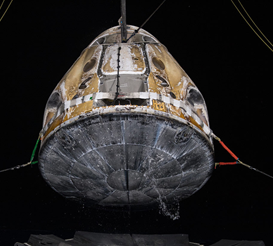We wish to estimate for Astronauts returning to the Earth with limited payload heat shields. In other words, we wonder whether the reentry vehicles bottom with an already 4-meter thick heat insulation layers can sustain the increasing burning off by frictional heating under different returning speed. The heat shield’s about 13-foot-diameter composite structure — located at the bottom, blunt end of the Dragon capsule — is detachable and interchangeable between the reusable spacecraft in SpaceX’s Dragon fleet (e.g. Dragon 1, flew 23 cargo missions to the Int’l Space Station (ISS) between 2010 and 2020 before being retired. SpaceX's CEO, Elon Musk, named the spacecraft after the 1963 song "Puff, the Magic Dragon" by Peter, Paul and Mary. For example, 63 foot tall Falcon-9, used $62 Millions per launch).

Figure 1 Dragon capsule — is detachable and interchangeable between the reusable spacecraft in SpaceX’s Dragon fleet. During a reentry, thermal protection system materials perform in temperature ranges from minus 250 F in the cold soak of space to entry temperatures that reach nearly 3,000 oF. Because the thermal protection system is installed on the outside of orbiter skin (used carbon-carbon material that won’t oxidize the outer surface is coated with silicon carbide designed by Rockwell Inc. and, Tom Stoebe of Wash U.), it established the aerodynamics function over the vehicle in addition to acting as the heat shield. The re-entry corridor is a narrow region in space that a re-entering vehicle must fly through. If the vehicle strays above the corridor, it may skip out.
If it stays below the corridor, it may burn up.
, in terms of air density
velocity
, drag coefficient
high Mach number collision cylinder with negligible sound speed
. e.g. H. Julian Allen NASA, Ames Research Center Moffett Field.1
The shortfall, if any, is that1 it costs $10,000 to put a pound of payload (over 50 thousand pounds per Spaceship/Satellite in Lower Earth Orbit (LEO) Space Station.2 For safety reason we cannot reduce the payload without enough safe -margin for the detachable and interchangeable between the reusable spacecraft.
In this paper, we wish to provide a kinetic estimation with a safe margin from the statistical mechanics viewpoint to take into account the material thermal accommodation coefficient
changes and the atmosphere molecular distribution function varies
from an extreme rarefied Knudsen gas at an infinite mean free path (mfp) all the way to the hydrodynamics continuum limit. The medium may be expressed in terms of a variable mean free path (mfp) parameter relative to size of the vehicle from infinite to zero. The challenges are two folds.1 The mean free path (mfp) will change from the dilute collision-less Knudsen gas level at the infinity mfp, all the way to continuum hydrodynamic continuum level. Moreover,2 the boundary condition is a variable in terms of Maxwell thermal accommodation coefficient:
, e.g. of which
will be specula reflection changing only the normal direction of velocity, the rest
component will be absorbed into the thick insulation wall and reaching the thermal equilibrium with the wall at the variable temperature
and diffusively re-emitted in Maxwell velocity equilibrium

Figure 2 The Smoke comes off in linear free flight until multiple collisions with air molecules to reach parabolic curvature.
The flower pollens motions are named after the botanist Robert Brown, who first described the phenomenon about two hundred years ago in 1827, in his doctoral thesis, under the supervision of Henri Poincare. Then, in 1905, Albert Einstein published a paper, explained as convincing evidence that atoms and molecules exist in water medium and was further verified experimentally by Jean Perrin in 1908, who was awarded the Nobel Prize in Physics in 1926 "for his work on the discontinuous structure of matter. We will review a probabilistic model of Albert Einstein and Marian Smoluchowski in the statistical mechanics, which converge (in hydrodynamic limit) to Brownian motion. In this way, Einstein was able to determine furthermore the size of atoms, and how many atoms there are in a mole, accordance to Avogadro's law, which is 22.4 liters at standard temperature and pressure with Avogadro number,
. The first part of Einstein's theory in 1926 consists in the formulation of a diffusion equation for Brownian particles, in which the diffusion coefficient
is related to the mean squared displacement of a Brownian particle, while the second part consists in relating the diffusion coefficient to measurable physical quantities such as friction, absolute temperature
. Since the re-entry vehicle final landing will be mostly likely in Oceans, we shall begin with Albert Einstein the Fluctuation and Dissipation theorem in liquid phase.
The diffusion equation has been derived by Adolf Fick in 1855.from the continuity equation, which states that a change in density is.
;
due to inflow and outflow of material where the vector flux of the diffusing material
and the diffusion constant
is the proportionality.
Theorem 1: Kinetic derivation of diffusion equation
Given kinetic distribution function
of space-velocity & time, we average away the velocity to derive the spatial density function
, which will satisfy a diffusion equation
In 1855, physiologist Adolf Fick first reported flux
is the diffusion flux, of which the dimension is the amount of substance per unit area per unit time.
measures the amount of substance that will flow through a unit area during a unit time interval. D is the diffusion coefficient or diffusivity. Its dimension is area per unit time.
Kinetic theory would begin that a regional time changes equals to its spatial change. The temporal density function
change in finite time
must equal to its spatial changes:
Proof:
where diffusion constant
with jump
probability density
Theorem 2: Solving the diffusion equation
Assuming the reentry space craft
in the vast space may be represented by Dirac delta generalized function
If
in terms of its Fourier transforms. We will adopt Fourier transform to replace the Laplacian operator
the diffusion equation is the Fourier space
Since the first order time integral gives an exponential function, then
; yields the final answer:
=
in the Fourier space, equivalently in the spatial domain:
; Q.E.D.
Since the rocket thrust must be sufficient to take care the mass weight of rocket, we can avoid involve the computation with mass, geometry, etc. consideration. We will concentrate on the kinetic collision boundary condition. Thus, for geometry simplicity of all kind of reentry vehicles, we develop the molecular fluctuation dissipation theorem, e.g. French Physics Maurice Couette suggested simplified object geometry, i.e. one plate moves with respect to the other plate with gases between two plates. Now we wish to verify the boundary condition based on molecular thermal motion as the origin of the fluctuations. Its local property shall have nothing to do with the geometry object of immersed object and its boundary interaction condition.

Figure 3 Plane couette flow,
; distance in terms of the mean free path
interns of number density
, and molecular collision cross section
.
We can prove the fluctuation and dissipation theorem without further ado; A solid body of mass M under Brownian motion is described by Paul Langevin (1832)-Newton force F(t) equation of the acceleration of the velocity
, and friction constant
of which the total force
: we will derive the fluctuation-dissipation theorem from the equal partition law in the isotropic1-D motion:
;
Setting the equal partition law per degree of freedom:
,
we have derived the fluctuation –dissipation theorem.
;
The devil of fluctuation-dissipation truth is in the detail of molecular-boundary collisions and inter-collisions.
- Fluctuating Kinetic Theory of discrete molecular phase space
formulation augmented the Ludwig Boltzmann Integral-differential equation with fluctuation Fox sources. We shall simplify the collision kernel by L. Bhatnagar, E.P. Gross, M. Krook (BGK) relaxation equation{2} (Am. Math Soc. Providence RI, 1963, Ch. IV), and keep the fluctuation Fox sources
(The Rockefeller Univ. 1970 Thesis of Ronald Fox)
Where in the LHS, we have omitted the acceleration force term
while in the RHS we have simplified the Boltzmann collision term with Stoke Ansatz collision kernel by the BGK relaxation decay model:
First of all we must introduce a fluctuation sources at solid boundary condition. Our goal is to demonstrate for an arbitrary Maxwell accommodation coefficient for absorbed and reemitted condition with the probability
that a Maxwellian distribution by the plate temperature dynamic condition
Before fluctuation and dynamic case, we first analyze equilibrium case that a stationary flow and the plate at the same temperature and a constant density of gas:
Linearized BGK equation for Cuette flow becomes
This must add boundary condition
and
We can write the Maxwell boundary conditions
is the inverse Knudsen number, and
is Maxwell thermal accommodation coefficients.
Solution of Fluctuation and Dissipation Relationship with BGK Boltzmann integral-differential equation with Fox sources, under an arbitrary Maxwell thermal accommodation
has been first given by Harold Szu’s dissertation in 1971 under Prof. George E. Uhlenbeck at the Rockefeller Univ. (Unpublished), the results can be compared with experiment data done by NASA and SpaceX Shuttle flights.
The complete Fluctuation-Dissipation solution can be found in Ph D dissertation of Harold Szu, Rockefeller University, 1971 (unpublished).
Further lab work
We shall estimate the Shuttle payload mass its average heat capacity of soil compared to the common sense, water 4,18 Joules of heat (1 kilocalorie) for the temperature of one kilogram of water to increase 1°C The specific heat of possible shuttle materials are listed in the following table specific heat defined as follows
[https://en.wikipedia.org/wiki/Specific_heat_capacity]
Specific Heat
capacity at a const. pressure versus const. volume (
isothermal compressibility,
coeff. Of thermal expansion;

Silicon won’t oxidize in the outer surface, as it is coated with silicon carbide designed by about 13-foot-diameter composite structure and 4 meter thick provided a burn-off mass generating the heat thermal energy should be equivalent, its general proof in the Appendix A.
Appendix A the Mass Energy Equivalence Relationship of Albert Einstein
Einstein's mass-energy equivalence becomes important in Space travel, because the payload mass is equivalent to the energy consumption. Conversely, the heat energy consumption is equivalent to the mass energy usage.
Lorentz transform
;
Q.E.D.
Verification of Lorentz transform in terms of slow speed limit as follows:
where the first term is zero velocity mass energy equivalence, and the second term is Newtonian kinetic energy, etc.
Appendix B Fluctuation-Dissipation Theory Estimated by BGK collision kernel.
There is more scientific eluciation in the 1971 Harold Szu PhD thesis of 100 pages (cf. Reference 5). For example, besides the bulk entropy source fluctuation that Ronny Fox derived and discussed in his 1970 Rockefeller Univ. PhD thesis, there are the boundary wall fluctuations that Harold Szu derived and discussed in a dilute atmosphere medium where Fox"s molecular collisions become rare, but the Szu's boundary fluctuations due to dilute molecular collision become important, and thus the Couette plate were chosen to demonstrate the boundary effect in a dilute gas case.
For the plane Couette flow, the stochastic BGK equations can be simplified to:
;
];
Putting
and assuming
independent of
, one gets back for
; while for
, one obtains
Note that
(1) Since the correlation of fluctuation source
is related to the collision kernel
if the intermolecular collision can be neglected in the Knudsen limit, then the effect of
will disappear.
(2) The drag depends on the accommodation coefficients
, while the Fox bulk fluctuations are independent of
. So that these fluctuations alone, the fluctuation-dissipation theorem cannot follow.
(3) There is a second source of fluctuation, which is due to the wall called wall fluctuations [Harold Szu 1971]. More details computation will not be presented but found in the dissertation The Rockefeller Univ., 1971, pp.1, 100.





